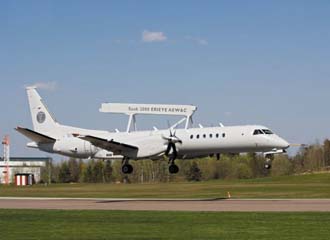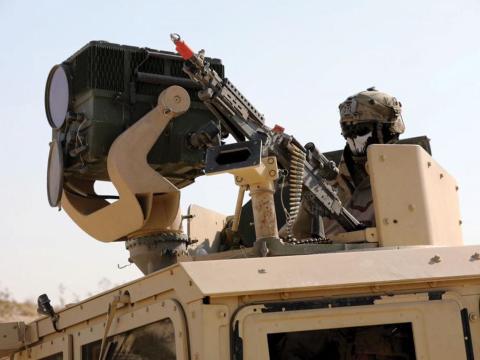Technology Sector Poised for Growth
Interoperability, outsourcing and exports drive Sweden’s technology market. 
Sweden’s Erieye radar is an Airborne Early Warning and Control System based on the Active Electronically Scanned Array.
Fueled by interoperability demands, outsourcing and exports, Sweden’s information technology market is likely to grow over the next few years, according to experts. With Sweden and many other countries increasingly focused on interoperability and outsourcing, Swedish industry is finding new opportunities both at home and abroad and looking forward to a period of surging business.
Business Monitor International (BMI), a financial markets analysis firm, predicts that Sweden’s information technology market will grow at a compound annual rate of four percent between 2010-2014. The domestic market is projected by BMI to reach nearly $18 billion in 2014. The computer hardware market, including desktop computers, notebooks and accessories, is expected to be worth about $3 billion by 2014, with software sales at more than $5 billion, and information technology services projected at about $8.5 billion. Still, the domestic market is relatively small, meaning exports are an essential part of doing business.
Both domestic and international markets are being driven in part by the need for interoperable systems. RAKEL, one of Sweden’s interoperable systems currently being deployed, features a handheld digital radio for military and emergency responders. RAKEL is an acronym that translates into English as “radio communication for effective management.” It is a digital radio communications system used by public policy, public security and public health organizations, including the police, the Swedish Rescue Services Agency, customs officials, the coast guard and the armed forces. The system is based on the Terrestrial Trunked Radio international standard that has been specially developed for civil protection and rescue services. Several countries in Europe already have installed the international standard technology, including Finland, Germany and Belgium. The system uses a low frequency, which provides greater range and high levels of geometric coverage with fewer transmitters. It also is programmed to ensure successful communication during emergencies.
In December, RAKEL became operational in Jämtland, Västerbotten and Norrbotten, so the architecture now is in place across the entire country. Implementation began in 2006, and the program has remained on schedule, according to government and industry sources.
Having an interoperable communications system in the hands of first responders and the military already is paying dividends, according to Helena Lindberg, director general of Myndigheten för Sam-hällsskydd och Beredskap (MSB), which is known in English as the Swedish Civil Contingencies Agency. When fire broke out aboard the Danish ferry Pearl of Scandinavia in November, Swedish emergency responders arrived quickly on the scene, and along with the ferry crewmembers were able to handle the situation effectively and efficiently. “A fire onboard a passenger ferry is a frightening thing to happen, and in that context RAKEL was a very effective tool of cooperation between the coast guard, police and the fire officials and rescue services. That was a very efficient way of coordinating the whole operation,” Lindberg says.
With the architecture now in place across the country, the task remains to convince some municipalities and agencies to adopt the system. “Now we have a huge challenge of getting all the sectors in Sweden to join in and to start using RAKEL. We’ve come quite far, but when it comes to local and regional levels and the health sector, the government hasn’t really a mandate to order the municipalities and the boards of health within the regions to use RAKEL. We have to convince that part of the Swedish society to join in,” Lindberg explains. “I am confident because, for one thing, the 200 radio analog networks we have in Sweden right now will not be operational in a few years.”
The country also is interested in purchasing systems that are interoperable with NATO, according to Gunnar Hult, deputy national armaments director of Sweden. “We have developed good relationships within NATO, and we’re looking at buying some of the systems they have developed, systems used in Afghanistan, for example. This is much more interesting for us now than developing our own uniquely Swedish systems, which are not compatible or interoperable,” Hult explains.
In some cases, however, it is Swedish technology that drives NATO interoperability. NATO has adopted the software-oriented architecture developed under Sweden’s network-centric warfare program Ledningssystem Teknik (LedsysT), which means “command and control systems technology.” LedsysT began about a decade ago as an effort to enable legacy command and control systems to share data with newer systems. “The aim was to make a software-oriented architecture, which could be a part of interoperability and make all the systems work together. The software-oriented architecture is now part of the NATO standard as well, so what they have done is to adopt what was done in Sweden,” says Jan Pie, secretary general of Säkerhets & Försvarsföretagen, or Swedish Security and Defense Industry, a trade group.
The government’s investment in LedsysT has resulted in the development of a variety of technologies, including information warfare and computer security technologies, as well as the Generalized Tactical Radio System (GTRS). Investment in the program has dwindled now that some of the systems are ready to begin fielding to Swedish forces in Afghanistan and elsewhere, Hult explains. GTRS will begin deployment within the next couple of years as part of a battle management system developed under LedsysT. During the first phase of deployment, GTRS will go to land forces and likely will be used in 2014 by Swedish forces participating in a European battle group—a rapid deployment, mobile combat force of about 2,500 troops on standby for deployment in case of crisis.
Saab flight tests an electronic warfare self-protection system using chaff and flares from a Swedish Armed Forces NH90 helicopter.
Pie credits LedsysT with influencing Sweden’s image as an innovative leader in the information technology arena. “LedsysT has had an impact on how Sweden is looked upon as an information technology country. Sweden has been in the forefront of the information technology business for many years now and is known in many areas as an innovative country.” 
Experts expect that innovation to continue with the Royal Swedish Navy’s next-generation A26 submarine, which will be built for network connectivity and designed with stealth in mind. “When it comes to building submarines that you can’t find, Sweden is the leader,” Pie says. In fact, in 2000 Sweden’s stealthy Gotland-class submarine participated in multinational exercises in the Mediterranean and remained undetected while gathering intelligence on ships from other countries. In 2005, the U.S. Navy requested permission to borrow a Gotland submarine and managed to detect the submarine only once during a two-year period, Pie reports.
In part because of its reputation as a technology innovator, Sweden attracts companies from around the world, including Microsoft Corporation, Hewlett-Packard and many others. In addition, Swedish companies such as Saab and Ericsson continue to expand business in the United States and elsewhere.
In addition to interoperability, Sweden and other governments increasingly seek to outsource some tasks, which presents opportunities for industry. The primary outsourcing efforts for the Swedish military include support and maintenance of the Saab SK-60 trainer aircraft, operation of a facility for exposing pilots to high gravitational forces, and the operation of air force radar stations in the far northern part of the country, above the Arctic Circle. “We think outsourcing is a win-win between government and industry. We’re always looking for new opportunities to outsource,” Hult says.
Sweden is a small country with a relatively small budget, so an effective export strategy is critical for companies there. In the defense and security sector, Swedish industry offers a variety of technologies, including communications, radar, aircraft countermeasures, command and control, space technology and many others, according to Pie.
In August, the government opened a new agency, the Swedish Defence and Security Export Agency (FXM), to promote defense exports that benefit Swedish defense and security policy. FXM also sells surplus equipment from the Swedish armed forces. The agency is expected to promote exports from medium and small defense contractors, as well as from larger companies. Previously, the agency’s tasks were spread out among various organizations and now centralized within FXM, according to Ulf Hammarström, the agency’s director general. “It is important for the government to have an instrument to overview and prioritize and ensure that export activities serve the purpose of the Swedish defense and security policy, but also to make it more effective for industry. Industry needs to know there is only one agency to turn to,” Hammarström states.
Industry sources agree that exports are vital for business success. Saab, one of Sweden’s largest exporters, along with Ericsson and others, has its export expansion eye on the other Nordic countries, the United Kingdom, the United States, South Africa, Australia and India. Saab delivers to 90 countries and has offices in 32, and much of its revenue comes from exports. The company also recently announced the creation of a new Swedish-Brazilian research and innovation center in São Bernardo do Campo, Brazil. The center will focus on aerospace, defense and civil security. Saab sells the Gripen fighter jet, is the prime contractor for RAKEL, has played a significant role in LedsysT and also will provide command and control technology for the new A26 submarine, according to Håkan Buskhe, the company’s president and chief executive officer.
Meanwhile, Ericsson, the inventor of Bluetooth technology, has reported strong growth in sales in North America and Japan. The mobile data market continues to grow in North America, and mobile broadband is in high demand in Japan. Ericsson does business in 175 countries, including the United States, Canada, and those located in Africa, Asia Pacific, Latin America and Middle East regions. Furthermore, 40 percent of all mobile calls are made through Ericsson networks, and the company boasts 25,000 patents.
With Sweden and other governments seeking greater interoperability and outsourcing opportunities, Swedish industry is prepared to deliver, according to experts. “We are ready for the competition,” Pie says.
WEB RESOURCES
Swedish Civil Contingencies Agency: www.msb.se/en/
Swedish Defence and Security Export Agency: www.fxm.se/inenglish.htm



